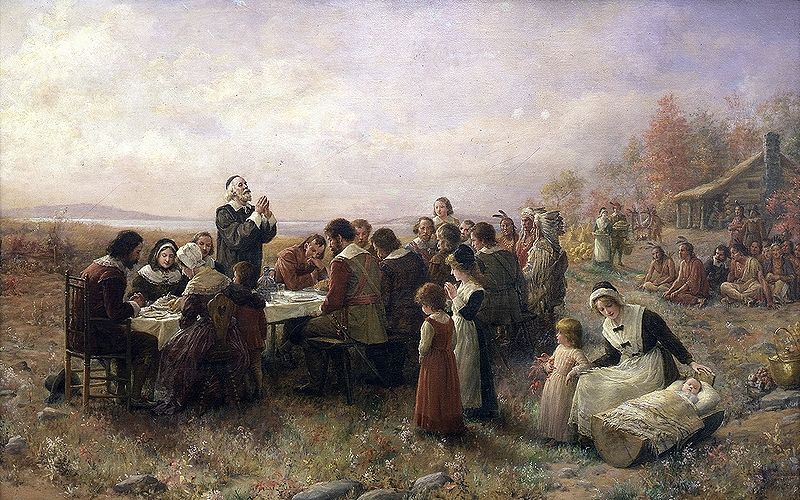That Broadway has played such a central role in recent events is fitting given the history of this street. It is perhaps New York City's oldest thoroughfare, growing with the city from its days as a coarse settlement to a bustling hub on the eastern seaboard. And in fact, it may be older than the New Amsterdam settlement:
The Manhattan Indians used the Wickquasgeck name for the path they took through the center of the island to [the] northern reaches. Coming south along it, Indians of various tribes reached the Dutch settlement at the southern end of the island. The Europeans could likewise follow it north—through stands of pin oak, chestnut, poplar, and pine, past open fields strewn with wild strawberries ... crossing the fast running brook that flowed southeast from the highlands in the area of Fifty-ninth Street and Fifth Avenue, more or less where the Plaza Hotel stands, to empty into a small bay on the East River—to hunt in the thick forest at the island's center and to fish the inlets that penetrated the eastern coast. As it was clearly destined to be the most prominent lane on the island, when the Dutch widened the path they referred to it as the Gentlemen's Street, or the High Street, or simply the Highway. The English, of course, called it Broadway (Shorto 2005: 60).
Well, the strawberries are long gone, but today we are going to walk the Wickquasgeck Trail—well, part of it anyway—and follow in the footsteps of early Dutch venturing into a lush wilderness and Native Americans coming to trade with the Dutch West India Company.
 We begin our walk at the southern end of the island, at the site of Fort Amsterdam. The Fort provided protection for settlers and served as a business center where trade for the Dutch West India Company took place. When Keift's War prompted retaliatory attacks from the Native American population, settlers would have taken refuge at the Fort—close your eyes and imagine them huddled here for protection. The area would grow to be a hub of activity—adjacent Bowling Green was at times a market and a promenade. It was also the site where Peter Minuit made the famous trade that shifted "ownership" of the land to the Dutch from the Lenape.
We begin our walk at the southern end of the island, at the site of Fort Amsterdam. The Fort provided protection for settlers and served as a business center where trade for the Dutch West India Company took place. When Keift's War prompted retaliatory attacks from the Native American population, settlers would have taken refuge at the Fort—close your eyes and imagine them huddled here for protection. The area would grow to be a hub of activity—adjacent Bowling Green was at times a market and a promenade. It was also the site where Peter Minuit made the famous trade that shifted "ownership" of the land to the Dutch from the Lenape. Today, the Alexander Hamilton Customs House stands at the site, which is also home to the New York branch of the Smithsonian's American Indian Museum. As Shorto notes, it is somewhat fitting that the site now preserves American Indian artifacts when it was meant to keep these people out. [Image Top Left: US Custom's House Nov. 2009, original site of Fort Amsterdam. Image Bottom Right: Bowling Green, Nov. 2009.]
Today, the Alexander Hamilton Customs House stands at the site, which is also home to the New York branch of the Smithsonian's American Indian Museum. As Shorto notes, it is somewhat fitting that the site now preserves American Indian artifacts when it was meant to keep these people out. [Image Top Left: US Custom's House Nov. 2009, original site of Fort Amsterdam. Image Bottom Right: Bowling Green, Nov. 2009.] Broadway remains a bustling artery through the city. Running north-south, parallel to the Hudson River, it is the only avenue to span the length of the island. The names of surrounding streets—Pine, Cedar, Spruce, Beaver, etc.—remind us of the woods that populated the land and of the heavy trade in furs that occurred here. Broadway was a choice residential area until the early 19th-century, when well-to-do residents began to move uptown as Manhattan expanded. The shipping industry moved in and the area came to be called "Steamship Row" (see page 8) for the shipping industries that took up the vacated town houses. [Image Left: Broadway, looking uptown. Nov. 2009.]
Broadway remains a bustling artery through the city. Running north-south, parallel to the Hudson River, it is the only avenue to span the length of the island. The names of surrounding streets—Pine, Cedar, Spruce, Beaver, etc.—remind us of the woods that populated the land and of the heavy trade in furs that occurred here. Broadway was a choice residential area until the early 19th-century, when well-to-do residents began to move uptown as Manhattan expanded. The shipping industry moved in and the area came to be called "Steamship Row" (see page 8) for the shipping industries that took up the vacated town houses. [Image Left: Broadway, looking uptown. Nov. 2009.] To follow the Wickquasgeck Trail, we need to continue along Broadway to Vesey/Ann Streets. It is here that present-day maps diverge from the original trail. To follow the original trail, we need to follow Park Row into the Bowery. The Bowery is another remnant from New York City's days as a Dutch settlement. The name Bowery comes from the Dutch bouwerie, meaning farm. And the area was perfect for farming in the days of the early colony. First settled by Africans, the Bowery was well outside the original settlement, and offered a respite from hectic daily life in the port settlement (as well as the settlement's taxes). [Image Right: Broadway diverges from the Wickquasgeck Trail at Broadway and Ann Street. Broadway is seen here on the left. The trail continues down Park Row, shown here on the right. Nov. 2009]
To follow the Wickquasgeck Trail, we need to continue along Broadway to Vesey/Ann Streets. It is here that present-day maps diverge from the original trail. To follow the original trail, we need to follow Park Row into the Bowery. The Bowery is another remnant from New York City's days as a Dutch settlement. The name Bowery comes from the Dutch bouwerie, meaning farm. And the area was perfect for farming in the days of the early colony. First settled by Africans, the Bowery was well outside the original settlement, and offered a respite from hectic daily life in the port settlement (as well as the settlement's taxes). [Image Right: Broadway diverges from the Wickquasgeck Trail at Broadway and Ann Street. Broadway is seen here on the left. The trail continues down Park Row, shown here on the right. Nov. 2009] At some point as Director-General, Peter (he preferred Petrus) Stuyvesant packed his wife and two young sons and his belongings into a wagon, and traveled to the Bowery to set up a farm. Perhaps his wife had gotten tired of living in the Fort—with two young boys and soldiers thundering in and out, it can't have offered many chances for peace and quiet. Whatever the reason, Stuyvesant would live out his days here after the colony was seized by the British—petitioning to do so after answering summonses by the Dutch to answer for the management of the colony. Today, Stuyvesant Street is the only remnant of his vast estate. He is buried in his family's vault located next to St. Marks-in-the Bowery.
At some point as Director-General, Peter (he preferred Petrus) Stuyvesant packed his wife and two young sons and his belongings into a wagon, and traveled to the Bowery to set up a farm. Perhaps his wife had gotten tired of living in the Fort—with two young boys and soldiers thundering in and out, it can't have offered many chances for peace and quiet. Whatever the reason, Stuyvesant would live out his days here after the colony was seized by the British—petitioning to do so after answering summonses by the Dutch to answer for the management of the colony. Today, Stuyvesant Street is the only remnant of his vast estate. He is buried in his family's vault located next to St. Marks-in-the Bowery. St. Marks was constructed in 1799, but prior to that, in 1660, Stuyvesant ordered a family chapel, the Dutch Reform Chapel, to be built on that spot. [Image Top Left: Stuyvesant Street is an short diagonal road that intersects 9th Street. Stuyvesant's Manor would have stood approximately where the red van is located. Nov. 2009. | Image Bottom Right: Stuyvesant's family vault at St. Marks. Judging by the stains on the marker, it would seem that the stern Director-General remains none too popular. Nov. 2009.]
St. Marks was constructed in 1799, but prior to that, in 1660, Stuyvesant ordered a family chapel, the Dutch Reform Chapel, to be built on that spot. [Image Top Left: Stuyvesant Street is an short diagonal road that intersects 9th Street. Stuyvesant's Manor would have stood approximately where the red van is located. Nov. 2009. | Image Bottom Right: Stuyvesant's family vault at St. Marks. Judging by the stains on the marker, it would seem that the stern Director-General remains none too popular. Nov. 2009.] Back on the trail, we would continue along the Bowery which becomes Fourth Avenue to 23rd Street—the edge of Stuyvesant's property. From here it is harder to follow it as it passes through present day buildings, but it crosses the northern end of Central Park westward to join Broadway, which continues through the Bronx, eventually becoming Route 9. [Image Left: Bust of Petrus Stuyvesant in graveyard of St. Marks near family vault. Nov. 2009].
Back on the trail, we would continue along the Bowery which becomes Fourth Avenue to 23rd Street—the edge of Stuyvesant's property. From here it is harder to follow it as it passes through present day buildings, but it crosses the northern end of Central Park westward to join Broadway, which continues through the Bronx, eventually becoming Route 9. [Image Left: Bust of Petrus Stuyvesant in graveyard of St. Marks near family vault. Nov. 2009].At the end of the Wickquasgeck Trail we would perhaps have encountered a American Indian village. It would have been a journey that took days, not hours. Who would have thought that a simple footpath would evolve into one of the most traveled routes in New York City.
I urge you all to step off the beaten path today—walk off the turkey and stuffing and explore. Let me know if you uncover any history along the way.
Cited:
Shorto, Russell. The Island at the Center of the World. New York: Vintage Books, 2005.





























